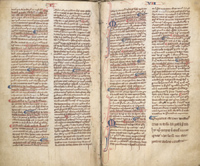 |
 |
 |
 |
 |
 |
 |
|
The infirmarer (continued) (7/13) The twelfth-century customary of the Order (Ecclesiastica Officia) discusses the infirmarer’s managerial duties in some detail, but says little of his medical knowledge. However, it is likely that he – and no doubt other members of the community – was well-versed in herbal remedies and administered herbs grown at the abbey. He probably had access to some medical and health-related books. Library catalogues and surviving manuscripts suggest that Cistercian libraries contained ancient and contemporary medical authorities, as well as herbals and other more traditional works. A thirteenth-century manuscript from Kirkstall Abbey, for example, contains a copy of the Medulla Philosophorum, a miscellany of tracts that includes explanations of various herbs and plants, as well as passages on indigestion, digestion and blood. The infirmarer would also have purchased lotions, potions and ready-made powders.(7)
A surviving ‘Bursar’s Book’ from Fountains Abbey, which lists the abbey’s expenses from 1456-59, shows that various medicines were purchased at that time for the abbot and the community.(8) These included a ‘pulvis vitalis’, a powder which was probably intended to promote vitality and strength, and a powder against the pestilence [pulvis pestilenciea]. This was evidently a rather exotic compound, consisting of sanders wood, basil seeds, Armenian bole, cinnamon, dittany, gentian and tormentil roots, citron and sorrel seeds, pearls, sapphires and the bone of a stag’s heart. In 1457-8 the community purchased this powder for the considerable sum of twelve shillings.(9) The ‘Bursar’s Book’ also lists pepper, ginger and liquorice, which were probably bought for medicinal purposes.
Much of the care of the sick would have been administered in-house, but lay medical practitioners were probably summoned to tend the seriously ill. This could be costly and it is likely that in many cases a physician was only called when absolutely necessary or to treat an important member of the community. Aelred, the third abbot of Rievaulx, was certainly tended by external physicians for it was upon their instruction that he drank a little wine, to ease the pain of urinary stones.(10) A London physician, Henry Wells, was summoned to Fountains Abbey in the mid-fifteenth century, when it was feared that William Downom, one of the monks, had poisoned Abbot John Greenwell. William had allegedly been provoked to this attack when the sick abbot refused the soup (pottage) that he had prepared for him.(11)
|
